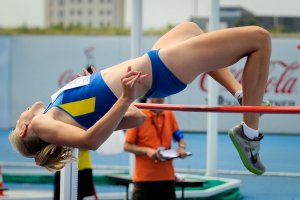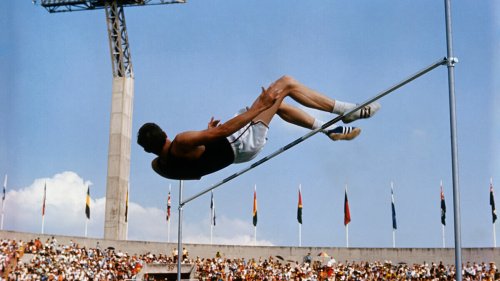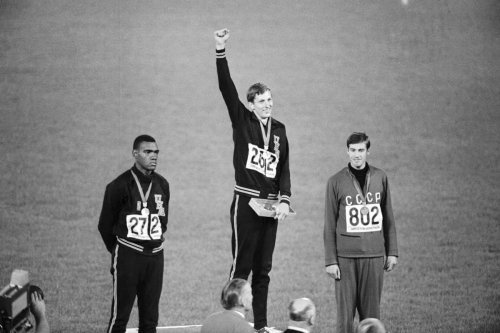Dick Fosbury and his High Jump Technique

When we watch athletes jump in the Olympic Games, the high jump technique they use amazes us. Would you like to know who invented it? His name is Dick Fosbury and he was an athlete who undoubtedly revolutionized the sport forever. We’ll tell you about him in the following article.
What was the high jump technique before Dick Fosbury?
Before talking about the Fosbury Flop, it’s worth mentioning that athletes used to jump differently at the Olympic Games, tournaments, and World Athletic Championships. Until 1968, there were three different techniques for the high jump:
1. The scissor technique
After a running start, the athlete would pass sideways through the bar. First with one leg and then with the other.
2. The western roll
Also known as the “California roll”, this technique included a half scissor and a back turn when reaching the highest point, which is over the bar. It basically consists of rotating in the air, around the bar…not simple at all!
3. The straddle jump
This third high jump technique started in 1936. It consists of jumping in the same way as the western roll but facing the bar.
Dick Fosbury and his leap for posterity
The techniques being used up until to that point were rather “natural” movements of the human body. If we have to jump a fence or any other obstacle, we’ll probably use the “scissors technique”. However, that doesn’t mean that they’re the most effective in terms of the sport we’re referring to.
That was Dick Fosbury’s way of thinking. He left everyone speechless at the 1968 Mexican Olympics, a competition that he classified for after winning the championship in his hometown (Oregon, United States). There wasn’t a hint of improvisation in his jump; in truth, he started practicing it when he was 16, back in 1963.

What does the technique consist of? Basically, you run towards the bar in a curved path and when you reach the bar, you jump with your back to it and extend your nearest arm. That way, the space between the center of gravity (the athlete’s body) and the obstacle to overcome (the bar) reduces, so you’ll gain height.
For this jump, some changes had to be made in the trials, of course; such as placing a mattress on the other side of the bar to avoid injuries or unfortunate blows. Until then, sand was used since athletes fell on their feet.
High jump technique: the day Dick Fosbury won gold
The 1968 Mexican Olympic Games have several important milestones that standout. For starters, they were the first games organized in Latin America. They were also the games of the famous “black power salute” and, of course, the Dick Fosbury revolution in the high jump.
The American athlete was only 21 years old when he arrived at the Mexican capital; willing to not only take a medal, but to forever change the world of athletics. In the final, he scored 2.24 meters and took the long-awaited gold medal.
Although Fosbury couldn’t exceed the 2.28 meters set by the Soviet Valeri Brumel (world record) with the straddle jump, the truth is that his contribution to the sport is undeniable. According to research, the way they jump gives athletes 40 centimeters more height.

Currently, all high jumpers use the Fosbury Flop because its effectiveness has been fully proven… although, in the beginning, athletes and experts in Olympism doubted this technique. They even made fun of Dick and told him he was “nuts” while practicing at the institute. On his triumphant return, those who laughed at his technique made him his hero.
Dick Fosbury retired at a young age, after failing to qualify for the 1972 Olympic Games in Munich. Without being the most skillful jumper of the time, through his innovation, he was able to not only win a gold medal, but to change the way athletes compete in the high jump forever.
With Dick Fosbury’s jump, athletes have been able to achieve really impressive marks, such as the one held by the Cuban Javier Sotomayor (2.45 meters) or the Bulgarian Stefka Kostadinova (2.08 meters). This is what it means to leave a mark in a sport!
When we watch athletes jump in the Olympic Games, the high jump technique they use amazes us. Would you like to know who invented it? His name is Dick Fosbury and he was an athlete who undoubtedly revolutionized the sport forever. We’ll tell you about him in the following article.
What was the high jump technique before Dick Fosbury?
Before talking about the Fosbury Flop, it’s worth mentioning that athletes used to jump differently at the Olympic Games, tournaments, and World Athletic Championships. Until 1968, there were three different techniques for the high jump:
1. The scissor technique
After a running start, the athlete would pass sideways through the bar. First with one leg and then with the other.
2. The western roll
Also known as the “California roll”, this technique included a half scissor and a back turn when reaching the highest point, which is over the bar. It basically consists of rotating in the air, around the bar…not simple at all!
3. The straddle jump
This third high jump technique started in 1936. It consists of jumping in the same way as the western roll but facing the bar.
Dick Fosbury and his leap for posterity
The techniques being used up until to that point were rather “natural” movements of the human body. If we have to jump a fence or any other obstacle, we’ll probably use the “scissors technique”. However, that doesn’t mean that they’re the most effective in terms of the sport we’re referring to.
That was Dick Fosbury’s way of thinking. He left everyone speechless at the 1968 Mexican Olympics, a competition that he classified for after winning the championship in his hometown (Oregon, United States). There wasn’t a hint of improvisation in his jump; in truth, he started practicing it when he was 16, back in 1963.

What does the technique consist of? Basically, you run towards the bar in a curved path and when you reach the bar, you jump with your back to it and extend your nearest arm. That way, the space between the center of gravity (the athlete’s body) and the obstacle to overcome (the bar) reduces, so you’ll gain height.
For this jump, some changes had to be made in the trials, of course; such as placing a mattress on the other side of the bar to avoid injuries or unfortunate blows. Until then, sand was used since athletes fell on their feet.
High jump technique: the day Dick Fosbury won gold
The 1968 Mexican Olympic Games have several important milestones that standout. For starters, they were the first games organized in Latin America. They were also the games of the famous “black power salute” and, of course, the Dick Fosbury revolution in the high jump.
The American athlete was only 21 years old when he arrived at the Mexican capital; willing to not only take a medal, but to forever change the world of athletics. In the final, he scored 2.24 meters and took the long-awaited gold medal.
Although Fosbury couldn’t exceed the 2.28 meters set by the Soviet Valeri Brumel (world record) with the straddle jump, the truth is that his contribution to the sport is undeniable. According to research, the way they jump gives athletes 40 centimeters more height.

Currently, all high jumpers use the Fosbury Flop because its effectiveness has been fully proven… although, in the beginning, athletes and experts in Olympism doubted this technique. They even made fun of Dick and told him he was “nuts” while practicing at the institute. On his triumphant return, those who laughed at his technique made him his hero.
Dick Fosbury retired at a young age, after failing to qualify for the 1972 Olympic Games in Munich. Without being the most skillful jumper of the time, through his innovation, he was able to not only win a gold medal, but to change the way athletes compete in the high jump forever.
With Dick Fosbury’s jump, athletes have been able to achieve really impressive marks, such as the one held by the Cuban Javier Sotomayor (2.45 meters) or the Bulgarian Stefka Kostadinova (2.08 meters). This is what it means to leave a mark in a sport!
All cited sources were thoroughly reviewed by our team to ensure their quality, reliability, currency, and validity. The bibliography of this article was considered reliable and of academic or scientific accuracy.
- Dapena, J. (1980). Mechanics of rotation in the Fosbury-flop. Medicine & Science in Sports & Exercise. https://doi.org/10.1249/00005768-198021000-00010
This text is provided for informational purposes only and does not replace consultation with a professional. If in doubt, consult your specialist.








